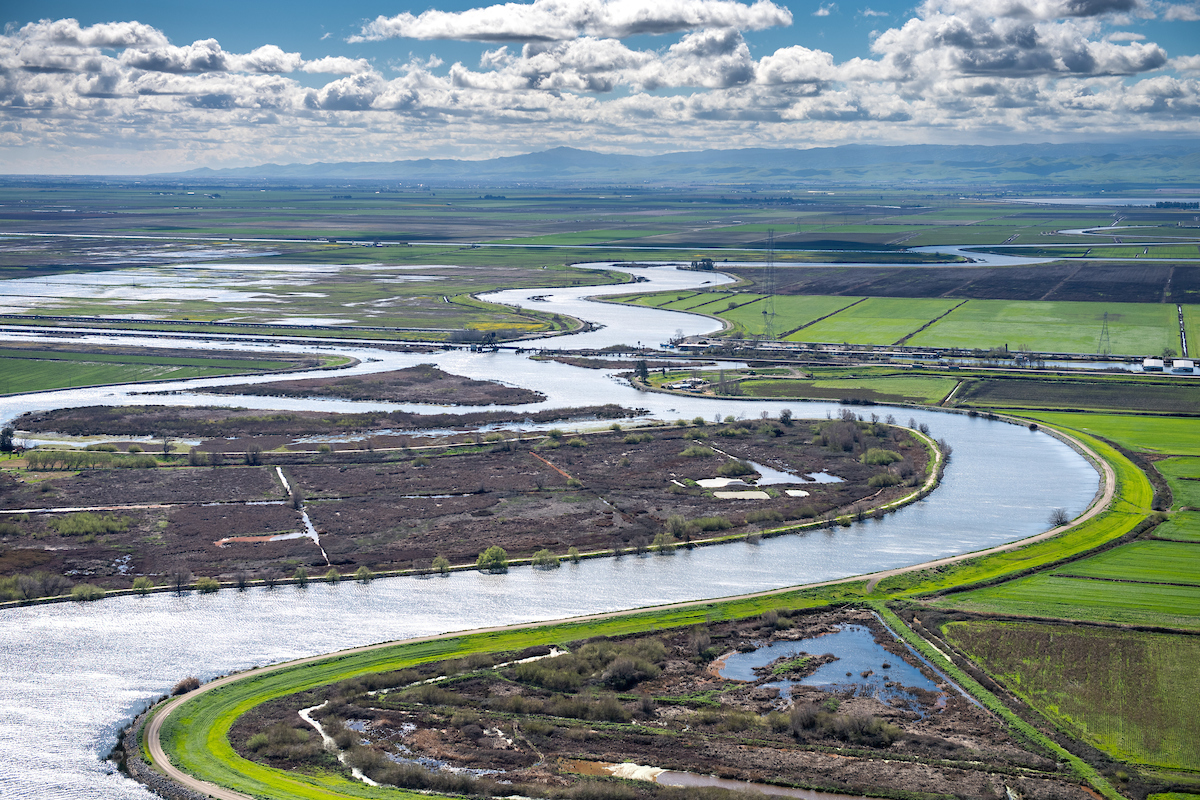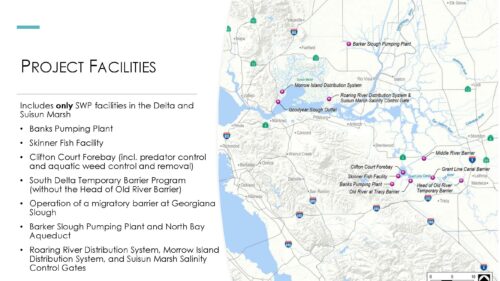Presentation provides an overview and details on the biological opinions and incidental take permit
For the Central Valley Project and the State Water Project to comply with the federal Endangered Species Act, the Bureau of Reclamation and the Department of Water Resources consult with the federal fish agencies, the National Marine Fisheries Service and the U.S. Fish & Wildlife Service, on the operation of the water projects. The federal fish agencies each then issue a biological opinion that includes specific actions intended to enable the long-term operations of the water projects without jeopardizing listed species. For the State Water Project to comply with the California Endangered Species Act, the Department of Fish and Wildlife issues an Incidental Take Permit to the Department of Water Resources through a similar process.
At the March meeting of the Delta Independent Science Board, board members heard presentations on the biological opinions and the incidental take permit for long-term operations of the State Water Project and Central Valley Project. The presentations addressed the process and goals of their respective processes, the uncertainties with species management, and how adaptive management is included in the permits.
National Marine Fisheries Service (NMFS) Biological Opinion
Cathy Marcinkevage is the assistant Regional Administrator of NOAA Fisheries California Central Valley office, where she manages the Division’s regulatory and scientific efforts to protect and recover listed species and sturgeon. In her presentation, she discussed the Endangered Species Act (ESA) and Section 7, focusing on the role of a federal agency in implementing the ESA; she noted that much of what she presents also is pertinent to the next presentation on the U.S. Fish and Wildlife as the same statute guides their work.
The consultation process
 The Endangered Species Act has several different components. Section 7 of the ESA requires that a federal agency undertaking any action must evaluate the impacts of that action and consult with the appropriate Service, either the National Marine Fisheries Service (NMFS) and/or the U.S. Fish and Wildlife Service (FWS), to identify the likelihood that that action could further jeopardize the continued existence of any listed species.
The Endangered Species Act has several different components. Section 7 of the ESA requires that a federal agency undertaking any action must evaluate the impacts of that action and consult with the appropriate Service, either the National Marine Fisheries Service (NMFS) and/or the U.S. Fish and Wildlife Service (FWS), to identify the likelihood that that action could further jeopardize the continued existence of any listed species.
For NMFS, the four species that require consultations are the endangered winter-run chinook salmon, threatened spring-run Chinook salmon, threatened California Central Valley steelhead, and threatened southern DPS of green sturgeon.
The role of the agency undertaking the action is to provide adequate information on the project to support NMFS’s analysis that identifies the risk of impacts to the species. The statute specifies that the best scientific and commercial information available should be used.
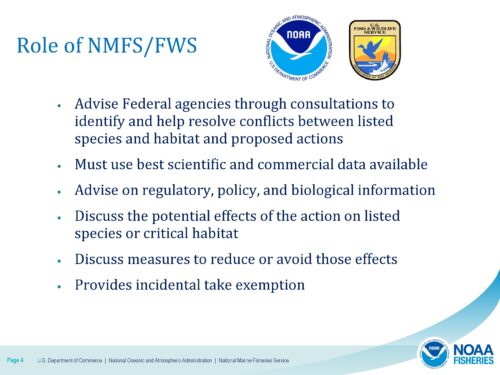 “That is intended to set us all up to have the most robust analysis that we can have,” said Ms. Marcinkevage, noting that they often work with the action agencies to provide technical assistance and inform them of the information needed. “Ultimately, the action agency defines the action. The role of the National Marine Fisheries Service or the Fish and Wildlife Service is to provide technical assistance as the project is developed. We strive to be active participants in the project development if we can be brought in early, but once consultation is initiated, we’ll do our own analysis, which again by the statute must be based on the best scientific and commercial information available.”
“That is intended to set us all up to have the most robust analysis that we can have,” said Ms. Marcinkevage, noting that they often work with the action agencies to provide technical assistance and inform them of the information needed. “Ultimately, the action agency defines the action. The role of the National Marine Fisheries Service or the Fish and Wildlife Service is to provide technical assistance as the project is developed. We strive to be active participants in the project development if we can be brought in early, but once consultation is initiated, we’ll do our own analysis, which again by the statute must be based on the best scientific and commercial information available.”
During the consultation, the impacts of the action on the species and the critical habitat are analyzed, and measures are recommended to minimize those impacts. The likelihood of jeopardizing the continued existence of the species is determined and, if applicable, an incidental take statement is issued, which is the permit that allows for unintentional but not unexpected harm to a limited number of individuals in executing the action.
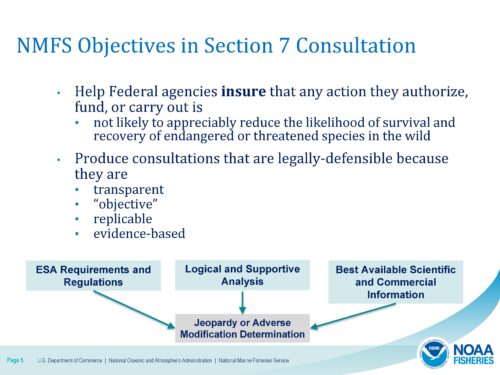 “Ultimately, our regulatory role is such that our objectives during the consultation and in our authorities are to help the action agency ensure that any action would not further jeopardize the species or adversely modify critical habitat,” said Ms. Marcinkevage. “Of course, we want to do that in a defensible, robust, logical, and scientifically sound way, so our analysis holds.”
“Ultimately, our regulatory role is such that our objectives during the consultation and in our authorities are to help the action agency ensure that any action would not further jeopardize the species or adversely modify critical habitat,” said Ms. Marcinkevage. “Of course, we want to do that in a defensible, robust, logical, and scientifically sound way, so our analysis holds.”
The statute states that to “jeopardize the continued existence of a listed species” is “to engage in an action that would be expected, directly or indirectly, to reduce appreciably the likelihood of both the survival and recovery of a listed species in the wild by reducing the reproduction, numbers, or distribution of that species” (50 CFR 402.02).
So how does NMFS do that? “We look at the various pathways of the effect of an action, we identify the risk to an individual fish, and that risk is based on the exposure of the fish to that pathway of effect,” she said. “Then we determine the response of the individual in terms of impacts to metrics like growth rate, survival, probability, and reproduction.”
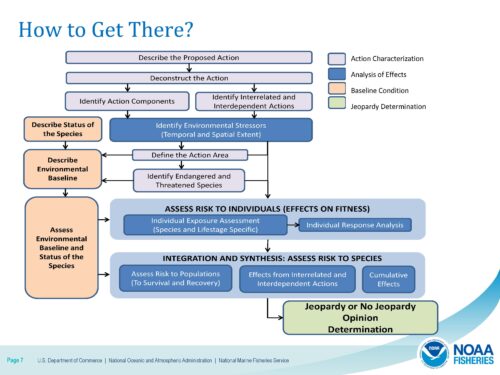 The graphic shows NMFS’s analytical approach. It starts with an understanding of the project, represented by the purple boxes at the top. This means making sure they understand the project, its different components, and the location in enough detail to determine the potential pathways of effect.
The graphic shows NMFS’s analytical approach. It starts with an understanding of the project, represented by the purple boxes at the top. This means making sure they understand the project, its different components, and the location in enough detail to determine the potential pathways of effect.
Next, they describe the current conditions of both the affected environment and the species, as shown by the orange boxes. Then they do their analysis, looking at the pathways of effect indicated by the blue boxes. They start with the impacts on the individual and aggregate that up to the effects on the population and, ultimately, the species.
“This is our approach to any consultation because we want a logical and clear evaluation of impacts,” said Ms. Marcinkevage.
There’s a lot of uncertainty with biological systems, so as much as NMFS tries to have a logical and scientific approach to the analysis and evaluation, they face uncertainties in determining the impacts of an action.
“Our approach is to employ institutionalized caution,” she said. “This is where the benefit of the doubt is given to the species; the species should not bear the burden, if you will, of that uncertainty. So we put some bounds on how we’re evaluating things, knowing that the information may not be perfect, but we need to work with it, though we do take a conservative attempt in interpreting that information.”
Ms. Marcinkevage noted that this is the standard practice for any consultation that we do, including the consultation on the long-term operations of the Central Valley Project and the State Water Project.
The Central Valley Project and State Water Project consultation
With the consultation on the Central Valley Project and the State Water Project, several pathways of effect were identified in the consultation, given the many action components for that project.
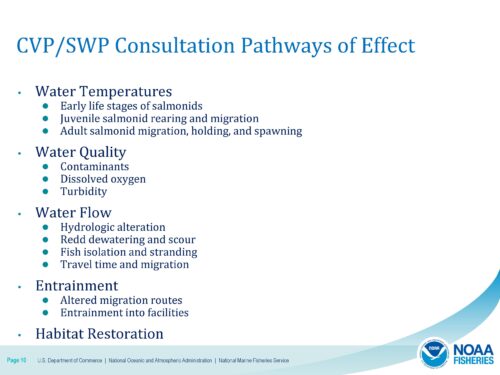 The slide lists the main pathways of concern for the NMFS. The impacts of the action, both positive and negative, are analyzed. “We see those impacts to the individuals as a result of the action,” she said. “Given the number of actions, species, and the number of life stages affected, especially for four different species that have multiple life stages throughout Central Valley, we definitely encountered uncertainty in all of these various pathways of effect.”
The slide lists the main pathways of concern for the NMFS. The impacts of the action, both positive and negative, are analyzed. “We see those impacts to the individuals as a result of the action,” she said. “Given the number of actions, species, and the number of life stages affected, especially for four different species that have multiple life stages throughout Central Valley, we definitely encountered uncertainty in all of these various pathways of effect.”
This uncertainty was addressed in the consultation by identifying biological performance metrics, such as temperature criteria and Delta survival, which are intended to ensure that the conditions that manifest reflect what was analyzed in the consultation. The consultation also included regular independent peer reviews of various scientific items and the performance metrics every four years with triggers for them to happen more frequently if needed.
The project also addresses uncertainties by identifying where those data gaps are in the project data and the efforts to address those. “The example I use here for the Central Valley Project consultation is the steelhead monitoring effort,” she said. “We found that it can be hard to quantify impacts to this species, given the variability and diversity in its life history expressions, and it was identified that a coordinated robust monitoring effort would be the start to providing the data needed to support a more honed evaluation of impacts.”
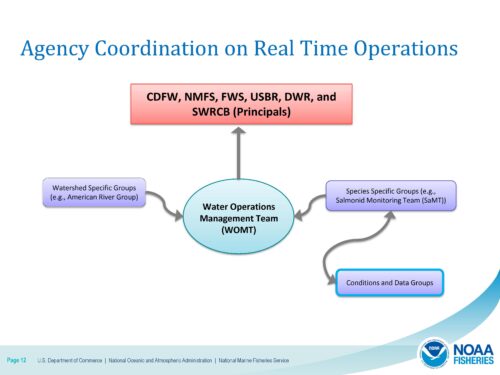 Operating the projects in real-time is not easy, requiring substantial coordination among all the state and federal agencies involved, Ms. Marcinkevage said, acknowledging that the graphic is oversimplified.
Operating the projects in real-time is not easy, requiring substantial coordination among all the state and federal agencies involved, Ms. Marcinkevage said, acknowledging that the graphic is oversimplified.
There are several meetings every week at various levels, from staff level up to director level, focused just on operations. In general, there are species-specific groups and watershed-specific groups looking at what’s happening with fish, hydrology, weather, and how those things change, as well as both the state and federal operations plans and permits. That information is then considered by the Water Operations Management Team or WOMT to recommend potential changes to operations. There is also a path for elevating issues provided by the directors of the different agencies for issues that come up or when a decision must be made.
Turning to the question of how the work of the Independent Science Board can assist them in their work, Ms. Marcinkevage said that identification of the best available science, especially that specific to the Delta and Central Valley, would be helpful. “There are many conversations about science to support management challenges in different arenas, but turning those conversations into real information that can be applied to the data gaps or applied to emergent science is crucial.”
Another challenge is that the species area spans from the Sierra to the sea, so synthesis efforts covering the broader landscape are incredibly useful.
“I recognize that the final resolution is often the right size for a tractable study question or a feasible funding opportunity, but stitching all that together to cover the full lifecycle of the species is really helpful for us.”
For more information:
- Biological Opinion for the Reinitiation of Consultation on the Long-Term Operation of the Central Valley Project and State Water Project, from the National Marine Fisheries Service
US Fish and Wildlife Service (FWS) Biological Opinion
Kaylee Allen is the Assistant Regional Director for Fish and Aquatic Conservation with the U.S. Fish and Wildlife Service (FWS), where she oversees two hatchery complexes and three Fish and Wildlife Offices that perform monitoring and restoration activities. She noted that her presentation will focus primarily on the Endangered Species Act, but the FWS has other regulatory functions under other legislation, such as the Fish and Wildlife Coordination Act, Federal Energy Regulation Commission (FERC), and others.
The National Marine Fisheries Service and Fish and Wildlife Service have joint authority to implement the Endangered Species Act; the Fish and Wildlife Service generally has jurisdiction over non-anadromous fishes and terrestrial species, and the National Marine Fisheries Service has jurisdiction over anadromous fish.
Ms. Allen noted that Ms. Marcinkevage covered Section 7, so she won’t repeat the information. However, she had a few points to add. “The action agency defines the proposed action that we’re analyzing, and because of that, where the Service might have goals and policies it’s trying to implement over time, Section 7 is not always the best vehicle to do that, because what we’re doing is helping the action agency implement their action and meet their goals.”
 She noted that the Fish and Wildlife Service works with the agency to help them understand the effects of their action on species and how they might be able to modify their action to have less harm, so they do like to be engaged early to provide technical assistance. However, once an agency has determined that its action may affect listed species, that’s when the consultation begins.
She noted that the Fish and Wildlife Service works with the agency to help them understand the effects of their action on species and how they might be able to modify their action to have less harm, so they do like to be engaged early to provide technical assistance. However, once an agency has determined that its action may affect listed species, that’s when the consultation begins.
“We work through the consultation process to help them understand the effects of their action and see if there are alternative paths that can still get them to their goals but do so in a less harmful manner,” said Ms. Allen. “The only time the Service would weigh in, in terms of an alternative to the action, is if the action was determined to jeopardize species or destroy or adversely modify critical habitat. And at that point, the Fish and Wildlife Service would work with the action agency to come up with alternative actions to avoid jeopardy or adverse modification [of critical habitat].”
 The state and federal water projects provide water for 25 million Californians, delivering to urban areas and millions of acres of farmland. The Delta is the hub of the water system where that water, for the most part, passes through on its way south. The Delta is also ecologically important, but multiple species are struggling.
The state and federal water projects provide water for 25 million Californians, delivering to urban areas and millions of acres of farmland. The Delta is the hub of the water system where that water, for the most part, passes through on its way south. The Delta is also ecologically important, but multiple species are struggling.
“Thinking about our Section 7 regulations and this project, our regulations don’t apply well to these ongoing projects,” said Ms. Allen. “The regulations are really focused on something much more tangible, such as a housing development where you have no development, and then you have development. Whereas with the operations of the CVP and SWP, you have existing facilities that have ongoing effects into the future, and changing an operation will also have ongoing effects. So trying to get your arms around what that really means and what that looks like is much more difficult than the basic Section 7 projects that we might do elsewhere.”
Overview of the 2019 consultation process
 The slide provides an overview of the 2019 consultation process for the long-term operations of the Central Valley Project and the State Water Project. Reclamation reinitiated consultation on the 2008-2009 biological opinions in August 2016. And in 2018, President Trump issued a memo identifying the critical milestones for consultation, which was intended to move very quickly.
The slide provides an overview of the 2019 consultation process for the long-term operations of the Central Valley Project and the State Water Project. Reclamation reinitiated consultation on the 2008-2009 biological opinions in August 2016. And in 2018, President Trump issued a memo identifying the critical milestones for consultation, which was intended to move very quickly.
In 2019, Reclamation completed its initial biological assessment. The assessment was released near the end of a 35-day government shutdown, which limited the ability of all of the agencies to participate in the finalization process.
During the first part of 2019, staff worked with Reclamation to understand all the aspects of the projects, and they performed the effects analyses. Later in 2019, the final biological opinions were issued. Then in February of 2020, Reclamation issued its record of decision on its NEPA document to implement those actions described in Reclamation’s biological assessment and analyzed in the biological opinions.
The Fish and Wildlife Service has jurisdiction over both terrestrial species and non-anadromous fishes, so the consultation focused on the effects on Delta smelt and its designated critical habitat, along with 15 terrestrial species. There were two rounds of peer review on both the FWS and NMFS biological opinions.
The biological opinions analyzed the effects of operations through 2030. “I’ve been involved in many of these operations consultations since 2000, and I think as we start to see the effects of climate change take hold, it’s been difficult for us to figure out how far out to look with these consultations,” said Ms. Allen. “There’s a lot of uncertainty just the further out you look. So we try to bite off manageable chunks, but also allow the action agency to fulfill its mission and implement its projects that it needs to rely on this consultation for.”
Ms. Allen noted there is litigation over the biological opinions and the NEPA document. The federal agencies are also seeking a voluntary remand of the 2019 opinion which would send the 2019 biological opinions back to the agencies to take another look.
Actions to protect Delta smelt
Ms. Allen then turned to the Delta smelt side of the consultation. Thinking about uncertainty with Delta smelt, they focused on ecological conditions for real-time management instead of surveying, which was the primary method in the past. The Delta smelt are much rarer than they used to be and the monitoring and sampling doesn’t provide the same level of information that they once did, she noted.
So, for example, one thing learned over the years of implementing the 2008 biological opinion is that smelt move with turbidity, so the biological opinion focuses more on the turbidity rather than the smelt surveys to guide real-time operations decisions.
 The biological opinion also includes a collaborative decision-making process that includes a smelt monitoring team and a salmon monitoring team that provides technical guidance to the agencies. The information works its way up to agency managers and ultimately to directors.
The biological opinion also includes a collaborative decision-making process that includes a smelt monitoring team and a salmon monitoring team that provides technical guidance to the agencies. The information works its way up to agency managers and ultimately to directors.
There are some adaptive management pieces built into the process. For example, there’s a summer-fall habitat action that provides additional habitat in Suisun Marsh, as well as ‘holding space’ for a technical group to develop additional actions. That group is currently working through a structured decision-making process about how to implement that summer-fall habitat action. There are also food web actions called for in the biological opinions.
They are developing guidance documents to knit together the requirements with Reclamation’s proposed action, the biological opinions, and the state’s action on the Incidental Take Permit. There have been weekly meetings to work through those guidance documents to try to have operations be as seamless as possible when the requirements in the biological opinions and the ITP are different.
Delta smelt enhancement
 As part of the proposed action, Reclamation proposes to supplement the wild population of delta smelt with captivity raised Delta smelt. Those fish are currently produced at UC Davis’s Fish Conservation and Culture Lab, and Reclamation is providing funding to extend the lab’s capacity.
As part of the proposed action, Reclamation proposes to supplement the wild population of delta smelt with captivity raised Delta smelt. Those fish are currently produced at UC Davis’s Fish Conservation and Culture Lab, and Reclamation is providing funding to extend the lab’s capacity.
The biological assessment called for supplementation within three to five years of issuing the Biological Opinion. So for the first year, the Service and partners worked through a supplementation strategy.
“We spent a year figuring out what we thought we needed to do,” said Ms. Allen. “We’re also looking at constructing a Fish Technology Center in the Delta that could benefit both Delta smelt and other Delta fishes. And then finally, Reclamation committed to building a larger hatchery facility for Delta smelt by 2030.”
Next, they developed the Experimental Release Program and worked on a regulatory strategy for getting fish in the water that involved a lot of agency collaboration. This involved making sure the fish were tagged, transporting them, and releasing them in the Delta. Ms. Allen acknowledged it’s been a tremendous effort by many people. The Department of Fish and Wildlife was the CEQA lead and a full partner; other partners include DWR, Reclamation, USGS, and UC Davis.
“Over the past three months, we’ve released over 55,000 marked fish into the Delta,” she said. “We transported the fish from the Fish Conservation and Culture Lab onto the boats and then into the water for our hard release.”
This year, they used multiple release sites, testing hard and soft release methods, with very little mortality at every stage they could see. She noted that as of yesterday (this presentation was March 11), they had sampled 38 marked fish in the Delta through their enhanced Delta smelt monitoring, so the fish, so far, are surviving.
With respect to how the ISB could be helpful, Ms. Allen agreed with Ms. Marcinkevage’s remarks, noting that the importance of synthesis cannot be underestimated.
“With all the agencies working on all these various projects, we tend to focus on our projects,” she said. “I think the ISB has that opportunity to provide an overarching role of what’s happening and maybe be able to see the gaps in the science more clearly. I think that’s a really important role that you play.”
For more information:
- Central Valley Project and California State Water Project Consultation
- Enhanced Delta Smelt Monitoring Program
- Delta Smelt and Longfin Smelt Research and Data
CA Department of Fish and Wildlife Incidental Take Permit
The next presentation was by Brooke Jacobs, an environmental program manager in the State Water Project Permitting Unit at the California Department of Fish and Wildlife.
She began with background information on the California Endangered Species Act, or CESA. California Fish and Game Code protect species listed as either endangered or threatened in California by prohibiting ‘take’ of the species, which is defined as hunt, pursue, catch, capture, or kill, or the attempt to hunt, pursue, catch, capture, or kill, endangered and threatened species.
However, some mechanisms allow activities to move forward that involve take of threatened and endangered species. One mechanism is an incidental take permit, which allows an exception to the take prohibition if a permittee implements certain conditions of approval specified by the Department that meet the standards for issuance. The incidental take permit (or ITP) contains measures roughly proportional to the impact of take. The applicant must ensure that they have adequate funding to implement those measures. All take must be minimized and fully mitigated, and the take must not jeopardize the species’ continued existence.
Incidental Take Permit for the State Water Project
The Incidental Take Permit (or ITP) issued to the State Water Project is a ten-year permit for 2020 to 2030. It includes four covered species: Delta smelt, longfin smelt, winter-run, and spring-run chinook salmon. Delta smelt, winter-run, and spring run are also listed under the Federal Endangered Species Act; longfin smelt is only listed as threatened under the California Endangered Species Act. The permit also includes an adaptive management program.
The project area or the geographic scope of the permit is the legal Delta, Suisun Marsh and Bay, and the portion of the Sacramento River from the Feather River Confluence to the I Street Bridge.
The permit authorizes take only for State Water Project facilities in the Delta and Suisun Marsh, including the Banks Pumping Plant, the Skinner Fish Facility, the Clifton Court Forebay, the South Delta Temporary Barrier Program, the operations of a migratory barrier at Georgiana Slough, Barker’s Slough Pumping Plant, South Bay Aqueduct, and the Suisun Marsh facilities.
Minimizing take
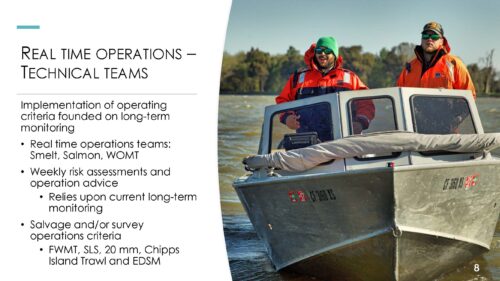 One of the main ways the ITP minimizes take of covered species is by implementing operating criteria founded on real-time operations on long-term monitoring data. So the Delta smelt and salmon real-time operations teams provide recommendations to the Water Operations Management Team (WOMT), who then synthesizes those recommendations. They meet weekly and use all of the available biological and hydrologic data in the Delta.
One of the main ways the ITP minimizes take of covered species is by implementing operating criteria founded on real-time operations on long-term monitoring data. So the Delta smelt and salmon real-time operations teams provide recommendations to the Water Operations Management Team (WOMT), who then synthesizes those recommendations. They meet weekly and use all of the available biological and hydrologic data in the Delta.
The permit is closely tied with IEP long-term monitoring, which is identified in the project description in the permit with the reference and acknowledgment of ongoing review of those IEP programs. Several IEP surveys are referenced in the operating criteria used for real-time operations, including the fall midwater trawl, smelt larva survey, Chipps Island trawl, 20-millimeter survey, and the Service’s enhanced Delta smelt monitoring program or EDSM.
 The slide provides a high-level overview of the different elements of the permit that deal with real-time operations. Ms. Jacobs noted that OMR stands for Old and Middle Rivers, and it’s an index of flows used to gauge both the volume and the direction of flows on those channels in the south Delta.
The slide provides a high-level overview of the different elements of the permit that deal with real-time operations. Ms. Jacobs noted that OMR stands for Old and Middle Rivers, and it’s an index of flows used to gauge both the volume and the direction of flows on those channels in the south Delta.
The permit includes measures that start and end an overall OMR management season that manages those flow levels when the covered species are present in the Delta. And then, within that season, there are measures targeted specifically at minimizing take of longfin smelt, Delta smelt, and both winter-run and spring-run Chinook salmon. There’s also a condition that limits the ability of the state water project to flex off of these export restrictions in the event of high flow or precipitation in the Delta.
Science and monitoring
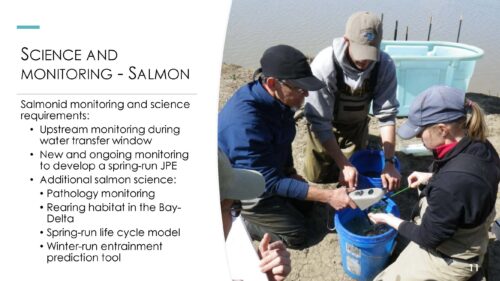 The permit also includes several requirements for new science and monitoring for salmon and smelt species intended to augment the current understanding of these species and better understand take and impacts of the taking as a result of State Water Project operations. The salmonid monitoring and science requirements include a requirement to conduct upstream monitoring to evaluate the potential effects on salmon, juveniles stranding, redd dewatering, and others during water transfers to determine if the water flow levels fluctuate too rapidly or too much. There’s also a requirement to conduct new and ongoing monitoring to develop a spring-run juvenile production estimate or JPE.
The permit also includes several requirements for new science and monitoring for salmon and smelt species intended to augment the current understanding of these species and better understand take and impacts of the taking as a result of State Water Project operations. The salmonid monitoring and science requirements include a requirement to conduct upstream monitoring to evaluate the potential effects on salmon, juveniles stranding, redd dewatering, and others during water transfers to determine if the water flow levels fluctuate too rapidly or too much. There’s also a requirement to conduct new and ongoing monitoring to develop a spring-run juvenile production estimate or JPE.
Other salmon science requirements in the permit include pathology monitoring to better understand the distribution and abundance of pathogens and their impacts on spring run, science to improve the understanding of rearing habitat for salmonids in the Bay-Delta, constructing a spring-run lifecycle model, and developing winter-run chinook salmon entrainment prediction tools.
The smelt science and monitoring conditions in the permit span a wide range of life history stages, such as conducting longfin smelt larval surveys earlier than in the past to better understand the start of longfin spawning season, and monitoring for smelt larval entrainment at the south Delta facilities.
There are science requirements pertaining to the Delta smelt summer-fall habitat action, such as requirements to monitor and report on the results every year, including those years when the action isn’t implemented. New monitoring stations in Grizzly Bay and Suisun Marsh are also required to better understand how abiotic factors in those areas change in response to summer-fall habitat actions.
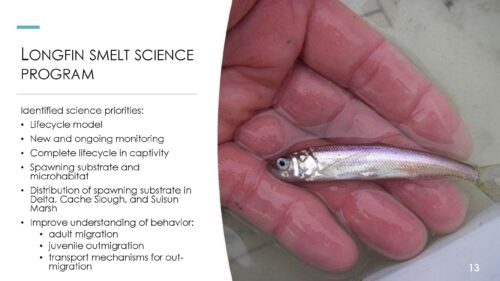 The longfin smelt science program described in the ITP is a continuation of a successful collaborative effort between the Department of Fish and Wildlife, the Department of Water Resources, and the State Water Contractors to develop questions regarding longfin smelt ecology and collaboratively initiate studies to answer those questions. That continues in the permit as a productive way to improve the understanding of the species’ ecology and potential impacts of take associated with State Water Project operations.
The longfin smelt science program described in the ITP is a continuation of a successful collaborative effort between the Department of Fish and Wildlife, the Department of Water Resources, and the State Water Contractors to develop questions regarding longfin smelt ecology and collaboratively initiate studies to answer those questions. That continues in the permit as a productive way to improve the understanding of the species’ ecology and potential impacts of take associated with State Water Project operations.
The longfin smelt science program has a science plan with identified science priorities that includes a lifecycle model for the species, new and ongoing monitoring for longfin smelt, completing the species’ lifecycle in captivity, and better understanding the spawning substrate in the Delta, Cache Slough, and Suisun Marsh. There is also a need to improve the understanding of key behavioral aspects of the species that pertain closely to take associated with the State Water Project, including adult migration patterns and transport mechanisms for juveniles out-migrating from the Delta.
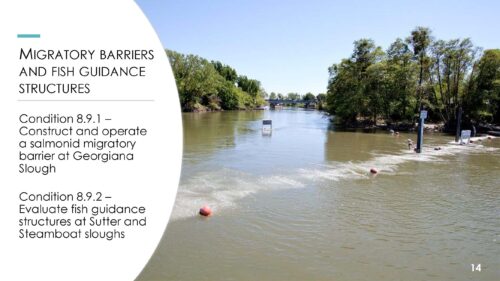 The permit also includes requirements to either implement or plan and study migratory barriers and fish guidance structures. The Department of Water Resources is required to construct and operate a salmonid migratory barrier at Georgiana Slough to keep migrating juvenile salmonids out of migration pathways that have known low survival rates and keep them on pathways that have much higher survival to improve their routing as they move from the tributaries down through the Delta and out.
The permit also includes requirements to either implement or plan and study migratory barriers and fish guidance structures. The Department of Water Resources is required to construct and operate a salmonid migratory barrier at Georgiana Slough to keep migrating juvenile salmonids out of migration pathways that have known low survival rates and keep them on pathways that have much higher survival to improve their routing as they move from the tributaries down through the Delta and out.
Conversely, there is a requirement to study and evaluate fish guidance structures at Sutter and Steamboat Sloughs intended to guide fish into areas with higher survival probabilities and keep them out of areas with much lower survival probabilities.
Ms. Jacobs noted that planning is well underway, and the hope is to implement the salmonid migratory barrier at the end of this water year and the following one.
Spring outflow blocks of water
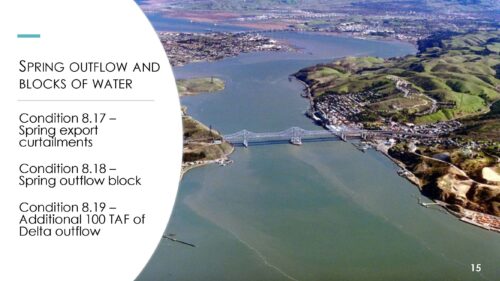 The permit also includes several conditions intended to augment spring outflow and provides blocks of water available for planning by the Department in collaboration with the Department of Water Resources. One of those is a requirement to conduct spring export curtailments in April and May of every year. These export curtailments are intended to augment spring outflow during these months to benefit all four of the covered species. Longfin smelt have the most well-known outflow and abundance relationship, but the action is also intended to benefit spring run, winter run, and Delta smelt.
The permit also includes several conditions intended to augment spring outflow and provides blocks of water available for planning by the Department in collaboration with the Department of Water Resources. One of those is a requirement to conduct spring export curtailments in April and May of every year. These export curtailments are intended to augment spring outflow during these months to benefit all four of the covered species. Longfin smelt have the most well-known outflow and abundance relationship, but the action is also intended to benefit spring run, winter run, and Delta smelt.
The ITP also includes a spring outflow block, which is a flexible management strategy that allows the Department of Water to flex off some of those restrictions to exports in the springtime. The amount of water captured would be tracked and made available to the Department of Fish and Wildlife in a block that could then be released later that summer, early fall, or even deferred to the subsequent year to provide benefits to species at other times when needed.
“It’s a flexible new approach that we have not tried yet, but it’s in the permit, so we have that tool available,” said Ms. Jacobs.
The permit also calls for an additional 100,000 acre-foot block of water made available for Delta outflow in any above normal or wet year as determined by the Sacramento Valley index. The 100,000 acre-feet is available to the Department, which will collaborate with the Department of Water Resources to schedule and plan how that water would be deployed to benefit the covered species. For example, it could augment Delta outflow or flows associated with a summer-fall habitat action.
Habitat restoration
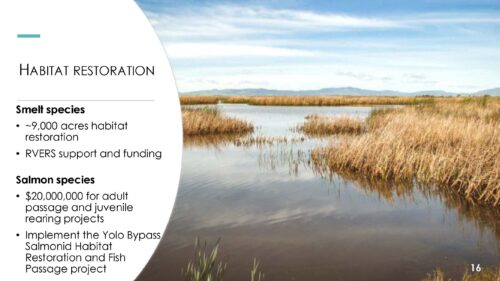 The permit also includes requirements for habitat restoration to mitigate take of all four of the covered species. It includes about 9000 acres of habitat restoration; it is carrying forward the 8000 acres of Delta smelt habitat restoration from the previous biological opinion, the 800 acres of longfin smelt habitat restoration in the incidental take permit for longfin smelt previous to this one, and then an additional 396 acres of habitat restoration intended to benefit both Delta and longfin smelt.
The permit also includes requirements for habitat restoration to mitigate take of all four of the covered species. It includes about 9000 acres of habitat restoration; it is carrying forward the 8000 acres of Delta smelt habitat restoration from the previous biological opinion, the 800 acres of longfin smelt habitat restoration in the incidental take permit for longfin smelt previous to this one, and then an additional 396 acres of habitat restoration intended to benefit both Delta and longfin smelt.
The permit requires the Department of Resources to provide a portion of the funding and support to construct and implement the RVERS Project for smelt species, as well as provide $20 million for adult passage in juvenile rearing projects that are identified in collaboration between the two departments during the course of the permit. And it requires the implementation of the Yolo bypass salmonid habitat restoration and fish passage project, otherwise known as the Big notch project in the Fremont Weir.
Adaptive management
The permit also has an adaptive management program. A draft adaptive management has been developed by a team that includes representatives from the Department of Fish and Wildlife, the Department of Water Resources, and the State Water Contractors. The effort is informed by Interagency Ecological Program, the Collaborative Science and Adaptive Management Program (or CSAMP), and the Delta Science Program.
“The adaptive management program is engaged on specifically the new science and monitoring required by the permit, and those portions that are explicitly tied to the adaptive management process in the permit,” said Ms. Jacobs. “We’re going to be evaluating the products from that and comparing them to current approaches in the permit. That may result in a request to amend the permit during its 10-year time frame.”
Science efforts explicitly tied to adaptive management:
The Summer-Fall habitat action
The Summer-Fall Habitat Action is explicitly tied to adaptive management. It is now being implemented through an annual planning process that is integrated with adaptive management and utilizes a structured decision-making process. The permit includes requirements to support this action that vary depending on water year type. These actions include operations of the Suisun Marsh salinity control gates, an X2 standard for above normal and wet years, the North Delta Flow action to provide food subsidies for portions of Delta smelt habitat and considering a Roaring River distribution system based food actions (which are still conceptual at this point). It includes improved monitoring in Grizzly Bay to better understand the low salinity zone habitat distribution when the Suisun Marsh salinity control gates are operated.
Winter-run entrainment tool
There is a desire amongst the agencies to develop an approach to minimize take of winter run at the facilities that is more proactive and not focused on having the individuals show up in salvage and then respond afterwards.
“We’d like to have something that’s more forward-looking to better anticipate take and minimize it before it starts,” said Ms. Jacobs. “So two models have been developed to serve this purpose. A model has been developed by ICF that looks at salvage patterns. When salvage starts at the facilities, it does an excellent job of understanding what future salvage will look like. That is one of the models being evaluated for this.”
“The other is a winter-run chinook machine learning project run by Jeremy Gaeta, Brian Mahardja, and Trinh Nguyen,” she continued. “It is a very complex A.I.-based machine learning model that looks at multiple factors and anticipates the beginning of winter-run salvage, either at one-week or three-week distances. These are both very exciting, and they’re both in development and getting ready to be tested.”
Juvenile Production Estimate
There is a requirement to develop a juvenile production estimate for spring-run Chinook salmon. This has already been done for winter-run, which is somewhat simpler because their geographic distribution is limited. Winter-run chinook salmon are distributed primarily along the Sacramento River, where there is an extensive monitoring enterprise that monitors the different life stages and enables the number of juveniles entering the Delta every year to be estimated.
“Spring-run salmon are much more difficult,” Ms. Jacobs said. “They have a more complex geographic distribution, and so we are launching this effort right now to look at all of our existing data for spring-run. We’ve started some new monitoring; there are two rotary screw traps that are beginning to gather new data to figure out how we could develop different modeling approaches to calculate the juvenile production estimate each year. The idea is that once this is up and running, it could be used to develop more proactive entrainment minimization measures for spring run that are not based on responding to observations of fish in salvage.”
The science plan extends from 2020 to 2024, at which point there will be an independent peer review panel of the different approaches and to receive feedback on what has been done to date.’
For more information:
QUESTION AND ANSWER HIGHLIGHTS
Dr. Robert Naiman: Directs question to Ms. Marcinkevage: I’ve always wondered if NOAA has the legal clout to require dams and other water diversions to install fish passage facilities.
Cathy Marcinkevage: “We do have passage criteria for projects in terms of sweeping velocity and things like that. It depends on the approach. With different authorities, we have some different opportunities to do that, such as under the Federal Power Act and our authorities there. We can do prescriptions that would require passage at structures. With Section 7, we can try to advocate and get projects to do things within our needs. But our job there is to analyze the project as it has come to us and identify its likelihood of jeopardizing the species.”
“Now, as we do that, if we were to find that this project will continue to be a barrier or impose a barrier that will impede passage, we could work out an alternative that would prevent that. It’s not necessarily easy to do. We do have some different authorities in different places. But there’s something to not wanting to come in and being the completely authoritarian with the heavy regulatory hand to impose something that, frankly, can’t be done, but rather work out a more workable solution.”
Dr. Robert Naiman: My understanding is that none of the dams within the Delta’s watershed have fish passage facilities, and yet you have endangered species that could use the habitat above the dam, assuming you can get them through the dams. In the Pacific Northwest and elsewhere, there have been a lot of retrofits for fish passage facilities as well as retrofits for regulating water temperatures in the rivers. And I was wondering who really has the authority to require the dams and other water diversions to do these kinds of things, if we’re going to have an effective ESA. So I don’t know whether it’s NOAA, FEMA, or Reclamation? Perhaps it’s the judicial system through the Ninth Circuit Court of Appeals?
Cathy Marcinkevage: “We have these changing conditions and potentially a changing baseline where we see that having fish on the valley floor probably will not be very good for them as we get further and further into climate change. So we do need to get them up above the dams into cooler water that is more reliably cold and spring-fed during drought years.
“In some instances, I completely get it. It’s physically incredibly challenging to do some type of passage structure. So what are some creative ways around that? There’s trap and haul that can work in some places, but that is not always the best approach. We’d love additional passage everywhere we can get it. But to be a realist, you may not get it everywhere. And you may need to do something that is non-volitional. But I agree with you; getting these species reintroduced into the areas above dams is a key component to their recovery. That’s in our recovery plans for salmonids, and it’s a big focus of our work over the coming years, especially given recurring drought conditions and warmer temperatures. We’re seeing things being done in the Northwest that maybe haven’t been adopted here in California quite as well yet.”
Dr. Robert Naiman directs the question to Ms. Allen: In your presentation, I came away with the impression that many of the Fish and Wildlife actions were defensive around jeopardy and losing habitat. Yet, I didn’t come away with the idea that you have many what I would call ‘offensive’ actions, where you’re really looking to increase the distribution or the population sizes of some of the listed species. Is that true or not?
Kaylee Allen: “My personal opinion is that Section 7 is fairly defensive. Again, we’re dealing with an action agency’s project and trying to make that the least harmful that we can. I think the Service overall has a lot of offensive-type actions, but they’re not regulatory per se. Part of our mission is to work with others to improve habitats. And so I think we’re at our strongest and most offensive when we’re working with others, whether it be through our restoration programs, such as the Central Valley Project Improvement Act, or our partners’ program, where we go out and work with people in the field and come up with actions that others can implement and that help contribute towards conservation. So in my mind, the ESA is an imperfect tool in terms of conservation, but it’s what we have. And so we utilize that to the extent that we can, but our other programs that are more outward facing, I think, provide much more benefit to conservation in the long run.”
Dr. Robert Naiman: In terms of your adaptive management program, does the state establish quantitative objectives for fish recovery that can be used within the adaptive management program, or are most of your objectives qualitative?
Brooke Jacobs: “Yes, the adaptive management program is working on coming up with both qualitative and quantitative criteria that would be used to evaluate those three high priority components that I talked about at the end of my talk. The team composed of my Department, Department of Water Resources, and State Water Contractors are doing that now. It has turned out to be quite difficult. It’s taken us a lot of careful thought over the past year to work on that. So that is part of it. But we can’t always have quantitative criteria because it’s just not possible; the information isn’t available.”
“However, they are not necessarily targeted at recovery. So we have some of the same constraints as under the federal endangered species act. Incidental take permits are intended to minimize and fully mitigate the take and impacts of take as a result of the projects. But we don’t have a recovery standard in that tool, so it’s not something that we can point to.”
“Other parts of the Department do have recovery focus, and we have recovery plans and other things that would speak to that, and that we can look at for information, but recovery isn’t the standard that we work towards.”
Dr. Steven Brandt asked, for each of you in your agencies, what proportion or maybe priority ranking is the fish science targeted towards regulations versus other fish work done? Is most of the science being done targeted toward those species? Or is it just one component of a much larger science program?
Kaylee Allen: “For us, our fish, particularly those that are listed, there’s a lot fewer than there are terrestrials. So for us, we target them a lot in the National Fish Hatchery System with our fish science, but it is probably less so than maybe some of the other agencies in the per capita way.
Cathy Marcinkevage: “I’m here representing NOAA Fisheries and the regulatory arm of the West Coast region. But we do also have our science centers. The Southwest Fisheries Science Center … is focused on a broader suite of species for sure. Within our office, we focus on the four listed species for the most part. … We are the regulatory arm of the agencies, but we are always looking for opportunities where science action can be taken, or studies can be done to better inform our regulatory roles and their management actions.
Brooke Jacobs: “For the Department, I work on the regulatory side. And so, by definition, I work primarily with the listed species, and that’s my perspective. That said, I can think of lots of examples of science efforts and positions dedicated to non-listed fish species in the Department. For example, we have a sportfish program out of our regional office. We just had a new fish biodiversity unit established in our fish branch that’s explicitly focused on non-listed species. And there are many other examples that I’m not mentioning at all. I don’t have an inventory that I could line up. But I would say definitely, that we do both because of the Department’s mission. We have a dual mission; we’re also focused on managing fish and wildlife resources and plant resources for use and enjoyment by the public. And that’s an important part of what we do, too.”
Dr. Virginia Dale directs question to Brooke Jacobs. You used the word fish salvage a lot. And that sounds to me like you’re focusing on the fish that survive. I know some entrainment work that TVA is doing is focusing on those who don’t survive to try to change conditions so they will. Am I understanding what fish salvage means correctly?
Brooke Jacobs: “When I talk about salvage, or I might have used the term loss, that’s when we observe one of the four listed fish species at the fish salvage facilities at either the State Water Project or Central Valley Project export facilities in the South Delta. So they subsample a total volume of the flow exported out of those facilities, then subsample the fish observed there and count them, and if there are listed species, that becomes salvage data. So we have a very long data set documenting that over many years.”
“We consider take as at the moment the fish enter the Clifton Court Forebay, which is before they even show up at salvage. So if we see them in salvage, we know that take is happening. And then, we have requirements to adjust operations to minimize that moving forward. So it’s an after-the-fact or ongoing indicator of take. Our goal in the permit is to move away from that and develop more proactive measures that would enable us to anticipate salvage and take and then make adjustments ahead of time.”
Dr. Robert Naiman: Do any of your respective programs have the authority or resources to purchase habitat or water rights in perpetuity? Is that part of your mission of what you could do?
Brooke Jacobs: “The Department administers several grant programs, and we take solicitations for numerous different types of projects, including habitat restoration projects. So our grant programs do have the ability to fund and support those activities. The Department has lands throughout the state as well. And we have talked about the idea of purchasing water rights in specific areas. My understanding is that that has not advanced maybe as quickly as some might have initially thought; it’s very complex. And it’s very difficult. But I do know, in very specific circumstances, people do talk about it and are trying to figure out ways to have that be workable.”
Kaylee Allen: “We generally take the approach of working with landowners, water rights holders, and others to help them utilize their resources to benefit conservation. I am aware of conversations around water rights purchases and other basins, but not in this area. So it seems like the authority must be out there, but I am not aware of it.”
Cathy Marcinkevage: “I’m haven’t heard of us doing that, especially the water rights component. But the partnership aspect of it to me is key. NOAA Fisheries is one of the smaller agencies compared to the others. And we have our recovery plans, which I referenced, which we are required to do under Section 4 of the ESA, but they don’t necessarily provide resources to carry out the actions that we identify in our recovery plan, so it’s almost an unfunded mandate. But those are the things that we use to guide our work with action agencies or with other partners.”
“For instance, a mitigation banker can purchase property that’s in a great spot for habitat restoration; that’s our opportunity to work with them and use other kinds of vehicles to help advance that restoration activity. So I think we latch on to the opportunities to partner with others to do that work, given that we tend not to have the resources to purchase one of the islands in the Delta and try to breach a levee … “
Brooke Jacobs: “The partnership aspects of the permit that we’ve developed with DWR include, for example, 100,000 acre-feet of Delta outflow under certain conditions. So that would be an example of something that we developed in collaboration with them that provides flow, but we haven’t purchased water rights specifically in that case.”
Dr. Robert Naiman: In the situation that I’m most familiar with, we work a lot with the tribes. And none of you mentioned tribal partners in any of your presentations. In the Pacific Northwest, the tribes are major partners in fish conservation. I’m really not up on whether or not tribes are important in the Delta. But it seems that if they are, they could be very good partners in a lot of these things. Do you see tribes as important, and if so, how do you work with them?
Cathy Marcinkevage: “There’s a different level or presence in California than in the Pacific Northwest with tribal engagement. We do tend to have increased tribal engagement further upstream in the tributary areas rather than the Delta itself. But we would engage with tribes; they are sovereign nations federally recognized in that government-to-government type of interaction that we do elsewhere throughout the region and throughout the country. We have identified opportunities to work with a few different tribes with some upstream actions that we’re trying to get going on. And, and it’s key; they’re an important interested party, just like anyone else, in what we’re trying to do.”
Kaylee Allen: “The tribal focus is very important for the Department of the Interior and emphasized consistently by our Secretary. … the treaties tribes have in the Pacific Northwest – they are not the same here in California. I think those treaties give tribes a more clear role in processes than we might have here. But I know that several tribal entities in the Delta are becoming more engaged in what’s going on in the water world. And I think that’s a really important step. And I’m happy to see it.”
Brooke Jacobs: “We have a Tribal Consultation Policy, and we offer the opportunity for consultation. We outreach to both state and federally recognized tribes, so we have an even broader, bigger list for communication. But within the Delta proper, there hasn’t been as much engagement to date.”


